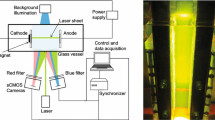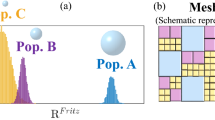Abstract
Experiments were conducted to study the effect of gas bubbles generated at platinum microelectrodes, on mass transfer at a series of copper strip segmented electrodes strategically located on both sides of microelectrodes in a vertical parallel-plate reactor. Mass transfer was measured in the absence and presence of gas bubbles, without and with superimposed liquid flow. Mass transfer results were compared, wherever possible, with available correlations for similar conditions, and found to be in good agreement. Mass transfer was observed to depend on whether one or all copper strip electrodes were switched on, due to dissipation of the concentration boundary layer in the interelectrode gaps. Experimental data show that mass transfer was significantly enhanced in the vicinity of gas generating microelectrodes, when there was forced flow of electrolyte. The increase in mass transfer coefficient was as much as fivefold. Since similar enhancement did not occur with quiescent liquid, the enhanced mass transfer was probably caused by a complex interplay of gas bubbles and forced flow.
Similar content being viewed by others
Abbreviations
- A :
-
electrode area (cm2)
- a :
-
constant in the correlation (k = aRe m, cm s−1)
- C R, bulk :
-
concentration of the reactant in the bulk (mol−1 dm−3)
- D :
-
diffusion coefficient (cm2 s−1)
- d h :
-
hydraulic diameter of the reactor (cm)
- F :
-
Faraday constant
- Gr :
-
Grashof number =gL 3Δρ/ν2ρ (dimensionless)
- g :
-
gravitational acceleration (cm s−2)
- i g :
-
gas current density (A cm−2)
- i L :
-
mass transfer limiting current density (A cm−2)
- k :
-
mass transfer coefficient (cm s−1)
- L :
-
characteristic length (cm)
- m :
-
exponent in correlations
- n :
-
number of electrons involved in overall electrode reaction, dimensionless
- Re :
-
Reynolds number =Ud hν−1 (dimensionless)
- Sc :
-
Schmidt number = νD −1 (dimensionless)
- Sh :
-
Sherwood number =kLD −1 (dimensionless)
- U :
-
mean bulk velocity (cm s−1)
- x :
-
distance (cm)
- δN :
-
‘equivalent’ Nernst diffusion layer thickness (cm)
- ν:
-
kinematic viscosity (cm2 s−1)
- Δϱ:
-
density difference = (ρL − ρ), (g cm−3)
- ϱL :
-
density of the liquid (g cm−3)
- ϱ:
-
average density of the two-phase mixture (g cm−3)
- ∈:
-
void fraction (volumetric gas flow/gas and liquid flow)
References
R. E. W. Jansson and R. Marshall,Electrochim. Act 27 (1982) 823.
W. S. Wu, G. P. Rangaiah and M. Fleischmann,J. Appl. Electrochem. 23 (1993) 113.
H. Vogt, ‘Gas Evolving Electrode in Comprehensive Treatise of Electrochemistry’, Vol. 6 (edited by E. Yeager, J. O'M. Bockris, B. E. Conway and S. Sarangapani), Plenum Press, New York (1983).
G. H. Sedahmed,J. Appl. Electrochem. 10 (1980) 351.
A. M. Ahmed and G. H. Sedahmed,J. Electrochem. Soc. 135 (1988) 2766.
H. Vogt,Electrochim. Acta 23 (1978) 203.
C. I. Elsner and S. L. Marchiano,J. Appl. Electrochem. 12 (1982) 735.
L. J. J. Janssenibid. 17 (1987) 1177.
H. Vogt,ibid. 19 (1989) 713.
M. G. Fouad and G. H. Sedahmed,Electrochim. Acta 18 (1973) 55.
L. J. J. Janssen and E. Barendrecht,ibid. 24 (1979) 693.
M. F. Sherbiny, A. A. Zatout, M. Hussien, G. H. Sedahmed,J. Appl. Electrochem. 21 (1991) 537.
P. J. Sides, ‘Modern Aspects of Electrochemistry’, No. 18 (edited by R. E. White), Plenum Press, New York (1986) 303.
N. Ibl,Electrochim. Acta 24 (1979) 1105.
L. Sigrist, O. Dossenbach and N. Ibl,Int. J. Heat & Mass Transfer 22 (1979) 1393.
O. N. Cavatorta, U. Böhm and A. M. Chiappori De Del Giorgio,J. Appl. Electrochem. 21 (1991) 40.
F. Giron, G. Valentin, M. Lebouche and A. Storck,J. Appl. Electrochem. 15 (1985) 557.
C. W. Tobias, M. Eisenberg and C. R. Wilke,J. Electrochem. Soc. 99 (12) (1952) 359C.
G. Marrucci and L. Nicodemo,Chem. Engg. Sci. 22 (1967) 1257.
R. A. M. Al-Hayes and R. H. S. Winterton.Int. J. Heat & Mass Transfer 24 (1981) 223.
D. J. Pickett, ‘Electrochemical Reactor Design’, Elsevier, Barking, UK (1977) Chapter 4.
N. P. Brandon and G. H. Kelsall,J. Appl. Electrochem. 15 (1985) 475.
G. Kreysa and M. Kuhn,ibid. 15 (1985) 517.
H. Vogt,ibid 17 (1987) 419.
E. J. Fenech and C. W. Tobias,Electrochim. Acta 2 (1960) 311.
Author information
Authors and Affiliations
Rights and permissions
About this article
Cite this article
Wu, W.S., Rangaiah, G.P. Effect of gas evolution on mass transfer in an electrochemical reactor. J Appl Electrochem 23, 1139–1146 (1993). https://doi.org/10.1007/BF00625587
Received:
Revised:
Issue Date:
DOI: https://doi.org/10.1007/BF00625587




